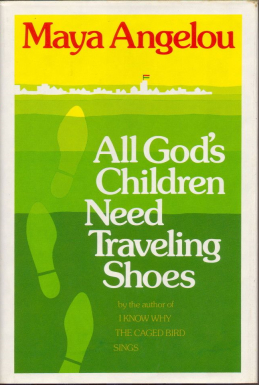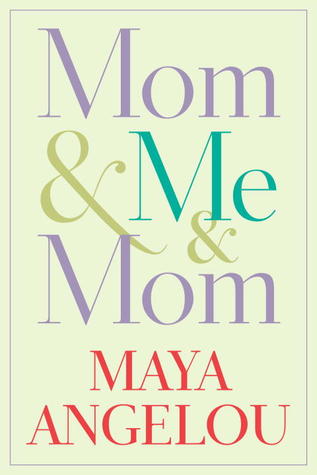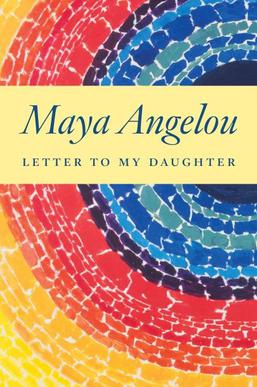Related Research Articles

Maya Angelou was an American memoirist, poet, and civil rights activist. She published seven autobiographies, three books of essays, several books of poetry, and is credited with a list of plays, movies, and television shows spanning over 50 years. She received dozens of awards and more than 50 honorary degrees. Angelou's series of seven autobiographies focus on her childhood and early adult experiences. The first, I Know Why the Caged Bird Sings (1969), tells of her life up to the age of 17 and brought her international recognition and acclaim.

I Know Why the Caged Bird Sings is a 1969 autobiography describing the young and early years of American writer and poet Maya Angelou. The first in a seven-volume series, it is a coming-of-age story that illustrates how strength of character and a love of literature can help overcome racism and trauma. The book begins when three-year-old Maya and her older brother are sent to Stamps, Arkansas, to live with their grandmother and ends when Maya becomes a mother at the age of 16. In the course of Caged Bird, Maya transforms from a victim of racism with an inferiority complex into a self-possessed, dignified young woman capable of responding to prejudice.
David Goldblatt HonFRPS was a South African photographer noted for his portrayal of South Africa during the period of apartheid. After apartheid had ended he concentrated more on the country's landscapes. What differentiates Goldblatt's body of work from those of other anti-apartheid artists is that he photographed issues that went beyond the violent events of apartheid and reflected the conditions that led up to them. His forms of protest have a subtlety that traditional documentary photographs may lack: "[M]y dispassion was an attitude in which I tried to avoid easy judgments. . . . This resulted in a photography that appeared to be disengaged and apolitical, but which was in fact the opposite." He has numerous publications to his name.

The Heart of a Woman (1981) is an autobiography by American writer Maya Angelou. The book is the fourth installment in Angelou's series of seven autobiographies. The Heart of a Woman recounts events in Angelou's life between 1957 and 1962 and follows her travels to California, New York City, Cairo, and Ghana as she raises her teenage son, becomes a published author, becomes active in the civil rights movement, and becomes romantically involved with a South African anti-apartheid fighter. One of the most important themes of The Heart of a Woman is motherhood, as Angelou continues to raise her son. The book ends with her son leaving for college and Angelou looking forward to newfound independence and freedom.

Art Wolfe is an American photographer and conservationist, best known for color images of landscapes, wildlife, and native cultures. His photographs document scenes from every continent and hundreds of locations, and have been noted by environmental advocacy groups for their "stunning" visual impact.

Ndebele house painting is a style of African art practiced by the Southern Ndebele people of South Africa and the Northern Ndebele people in Zimbabwe in Matobo. It is predominantly practiced by the Ndebele women.

Singin' and Swingin' and Gettin' Merry like Christmas is the third book of Maya Angelou's seven-volume autobiography series. Set between 1949 and 1955, the book spans Angelou's early twenties. In this volume, Angelou describes her struggles to support her young son, form meaningful relationships, and forge a successful career in the entertainment world. The work's 1976 publication was the first time an African-American woman had expanded her life story into a third volume. Scholar Dolly McPherson calls the book "a graphic portrait of the adult self in bloom" and critic Lyman B. Hagen calls it "a journey of discovery and rebirth".

All God's Children Need Traveling Shoes, published in 1986, is the fifth book in African-American writer and poet Maya Angelou's seven-volume autobiography series. Set between 1962 and 1965, the book begins when Angelou is 33 years old, and recounts the years she lived in Accra, Ghana. The book, deriving its title from a Negro spiritual, begins where Angelou's previous memoir, The Heart of a Woman, ends — with the traumatic car accident involving her son Guy — and closes with Angelou returning to America.

A Song Flung Up to Heaven is the sixth book in author Maya Angelou's series of autobiographies. Set between 1965 and 1968, it begins where Angelou's previous book All God's Children Need Traveling Shoes ends, with Angelou's trip from Accra, Ghana, where she had lived for the past four years, back to the United States. Two "calamitous events" frame the beginning and end of the book—the assassinations of Malcolm X and Martin Luther King Jr. Angelou describes how she dealt with these events and the sweeping changes in both the country and in her personal life, and how she coped with her return home to the U.S. The book ends with Angelou at "the threshold of her literary career", writing the opening lines to her first autobiography, I Know Why the Caged Bird Sings.

Wouldn't Take Nothing for My Journey Now, published in 1993, is African-American writer and poet Maya Angelou's first book of essays. It was published shortly after she recited her poem "On the Pulse of Morning" at President Bill Clinton's 1993 inauguration. Journey consists of a series of short essays, often autobiographical, along with two poems, and has been called one of Angelou's "wisdom books". It is titled after a lyric in the African American spiritual, "On My Journey Now." At the time of its publication, Angelou was already well respected and popular as a writer and poet. Like her previous works, Journey received generally positive reviews.

The themes encompassed in African-American writer Maya Angelou's seven autobiographies include racism, identity, family, and travel. Angelou (1928–2014) is best known for her first autobiography, I Know Why the Caged Bird Sings (1969). The rest of the books in her series are Gather Together in My Name (1974), Singin' and Swingin' and Gettin' Merry Like Christmas (1976), The Heart of a Woman (1981), All God's Children Need Traveling Shoes (1986), A Song Flung Up to Heaven (2002), and Mom & Me & Mom (2013).

Even the Stars Look Lonesome (1997) is African-American writer and poet Maya Angelou's second book of essays, published during the long period between her fifth and sixth autobiographies, All God's Children Need Traveling Shoes (1986) and A Song Flung Up to Heaven (2002). Stars, like her first book of essays, Wouldn't Take Nothing for My Journey Now (1993), has been called one of Angelou's "wisdom books". By the time it was published, Angelou was well-respected and popular as a writer and poet. She discusses a wide range of topics in the book's twenty short personal essays, including Africa, aging and the young's misconceptions of it, sex and sensuality, self-reflection, independence, and violence. Most of the essays are autobiographical and had previously appeared in other publications. One essay defends Angelou's support of Supreme Court justice Clarence Thomas, and another one centers on her friend Oprah Winfrey.

Mom & Me & Mom (2013) is the seventh and final book in author Maya Angelou's series of autobiographies. The book was published shortly before Mother's Day and Angelou's 85th birthday. It focuses, for the first time in her books, on Angelou's relationship with her mother, Vivian Baxter. The book explains Baxter's behavior, especially Baxter's abandonment of Angelou and Angelou's older brother when they were young children, and fills in "what are possibly the final blanks in Angelou's eventful life". The book also chronicles Angelou's reunion and reconciliation with Baxter.

Letter to My Daughter (2009) is the third book of essays by African-American writer and poet Maya Angelou. By the time it was published, Angelou had written two other books of essays, several volumes of poetry, and six autobiographies. She was recognized and highly respected as a spokesperson for black people and women, and had become "a major autobiographical voice of the time". Angelou had no daughters herself, but was inspired to write Letter as she was going through 20 years of notes and essay ideas, some of which were written for her friend Oprah Winfrey. Angelou wrote the book for the thousands of women who saw her as a mother figure, and to share the wisdom gained throughout her long life.

Maya Angelou, an African-American writer who is best known for her seven autobiographies, was also a prolific and successful poet. She has been called "the black woman's poet laureate", and her poems have been called the anthems of African Americans. Angelou studied and began writing poetry at a young age, and used poetry and other great literature to cope with trauma, as she described in her first and most well-known autobiography, I Know Why the Caged Bird Sings. She became a poet after a series of occupations as a young adult, including as a cast member of a European tour of Porgy and Bess, and a performer of calypso music in nightclubs in the 1950s. Many of the songs she wrote during that period later found their way to her later poetry collections. She eventually gave up performing for a writing career.

Margaret Yvonne Busby,, Hon. FRSL, also known as Nana Akua Ackon, is a Ghanaian-born publisher, editor, writer and broadcaster, resident in the UK. She was Britain's youngest and first black female book publisher when she and Clive Allison (1944–2011) co-founded the London-based publishing house Allison and Busby in the 1960s. She edited the anthology Daughters of Africa (1992), and its 2019 follow-up New Daughters of Africa. She is a recipient of the Benson Medal from the Royal Society of Literature. In 2020 she was voted one of the "100 Great Black Britons". In 2021, she was honoured with the London Book Fair Lifetime Achievement Award. In 2023, Busby was named as president of English PEN.
Lava Thomas is an American artist. Thomas was born and raised in Los Angeles.

Jewelleryof the Berber cultures is a historical style of traditional jewellery that was worn by women mainly in rural areas of the Maghreb region in North Africa and inhabited by indigenous Berber people. Following long social and cultural traditions, Berber or other silversmiths in Morocco, Algeria and neighbouring countries created intricate jewellery with distinct regional variations. In many towns and cities, there were Jewish silversmiths, who produced both jewellery in specific Berber styles as well as in other styles, adapting to changing techniques and artistic innovations.
References
- 1 2 3 Reif, Rita (22 June 1986). "ANTIQUES; AN AFRICAN TRIBE'S ART IS ENDANGERED". The New York Times. ISSN 0362-4331 . Retrieved 2021-09-18.
- ↑ "Camogli: P46 Gallery, inaugurata la mostra di Margaret Courtney-Clarke". LevanteNews. 5 May 2018. Retrieved 2021-09-19.
- 1 2 "Seven groundbreaking female photographers – in pictures". The Guardian. 14 December 2020. Retrieved 2021-09-18.
- 1 2 Goldblatt, David (6 February 2018). "The Fragility of Existence". Aperture Foundation . Retrieved 2021-09-19.
- 1 2 "ART OF AFRICAN WOMEN EXHIBIT OPENS OCT. 8 AT NYS MUSEUM". New York State Museum. Retrieved 2021-09-18.
- 1 2 "African art". The Philadelphia Inquirer, LLC . 12 January 2007. Retrieved 2021-09-18.
- 1 2 "Prix Pictet 2019 shortlist – photo essay". The Guardian. 5 July 2019. Retrieved 2021-09-18.
- ↑ "Margaret Courtney-Clarke - Namibian Photographer". hundredheroines.org. Retrieved 2021-09-18.
- 1 2 Stimpson, Catharine R. (2 September 1990). "Their Workaday Art". The New York Times. ISSN 0362-4331 . Retrieved 2021-09-19.
- 1 2 "Margaret Courtney-Clarke". SMAC Gallery. Retrieved 2021-09-19.
- ↑ "Local exhibition spotlights friendship between Maya Angelou and Margaret Courtney-Clarke". www.iol.co.za. Retrieved 2021-09-19.
- ↑ Daniels, Nicola (20 August 2021). "Don't miss Maya Angelou exhibition in Cape Town". Cape Times.
- ↑ "Imazighen". www.kirkusreviews.com.
- ↑ "Margaret Courtney-Clarke: Imazighen". www.margaret-courtney-clarke.com. Retrieved 2021-09-20.
- ↑ "'Cry Sadness into the Coming Rain' launched at Swakop". The Namibian . Retrieved 2021-09-18.
- ↑ "Margaret Courtney-Clarke". Prix Pictet. 4 July 2019. Retrieved 2021-09-20.
- ↑ Brown, Patricia Leigh (2 August 1990). "Currents; Images of a Homeland in West Africa". The New York Times. ISSN 0362-4331 . Retrieved 2021-09-19.
- ↑ "Photo London: the 2018 Kraszna-Krausz shortlist - 1854 Photography". British Journal of Photography. Retrieved 2021-09-19.